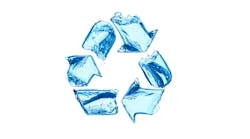Q: Why has perchlorate in drinking water been a controversial issue, and what is the current status? Is it a good candidate for a national regulation in drinking water?
A: Perchlorate is one of several anions that compete with iodide transport that can cause thyroid and indirect neurological problems in high risk persons at sustained, high enough doses. Benefits versus costs of a national regulation are questionable.
Background
This is a more detailed update of Water Technology’s May 2013 Contaminant of the Month article. In 2008, EPA had proposed not to regulate perchlorate in drinking water and issued an interim Drinking Water Health Advisory (DWHA) of 15 parts per billion (ppb) based upon a review, recommended assessment and reference dose provided by the National Research Council (NRC). EPA reversed itself in 2011, issuing a determination to regulate perchlorate with a different interpretation of the requirements in the Safe Drinking Water Act that must be met to arrive at a decision to regulate.
Where does it come from?
Perchlorate, with the chemical formula ClO4– , is an anion and a strong oxidizing agent because chlorine is in its highest oxidation state of +7. In water it is always associated with a cation, such as hydrogen, sodium or potassium. Perchloric acid is a strong acid and the salts are ionized and stable in water. It is stable in its pure state if not in contact with reducing agents and if kept below approximately 150o C, where it becomes thermodynamically unstable. Perchlorate is a natural product of solar irradiation of chlorine species, found in minerals, and a commercial strong oxidizing agent used in explosives, flares, fireworks and as a rocket fuel component. It is also present in aged hypochlorite solutions as a secondary product after chlorate accumulates from storage at warm temperatures.
Occurrence and human exposure
Perchlorate can be present in ppb amounts in dairy products and produce and is also in some fertilizers. It is not metabolized after ingestion and is excreted unchanged with a half-life of eight to 12 hours.
The Food and Drug Administration (FDA) has estimated dietary exposures in the U.S. to be age dependent from 0.11 to 0.39 µg/kg/day, with younger individuals having the higher exposures on a per kilogram body weight basis. The WHO/FAO Joint Expert Committee on Food Additives (JECFA) estimated 0.7 µg/kg bw/day as the high, and 0.1 µg/kg bw/day as the mean from food and water.
Detailed U.S. drinking water occurrence data was generated by the Unregulated Contaminants Monitoring Rule (UCMR 1), which included analyses in 2001-2005 from 2,800 public water systems larger than 10,000 plus 800 out of 50,000 small systems. Of 3,865 reporting systems, only 160 (4.1 percent) had one or more measurements at or above 4 ppb — the then reporting limit. The average of the positives was 9.85 ppb, the median was 6.4 ppb and 15 systems exceeded 15 ppb. EPA estimated that between 5.1 million and 16.6 million people were served in the systems exceeding > 4 ppb, and between 0.4 million and one million in those exceeding 23 ppb.
From another impact analysis, about four percent of all systems would exceed an MCL of 2 ppb, three percent at 4 ppb, about 0.5 percent at 15 ppb and 0.2 to 0.3 percent at an MCL of 24 ppb.
Human health
Perchlorate and other anions in the diet, (nitrate, chlorate, bromide), smoking (thiocyanate) and in drinking waters compete with iodide transport to the thyroid, which can reduce production of thyroid hormones, increasing the risk of hypothyroidism if iodine intake is not adequate. Perchlorate is more potent on a unit basis than the other anions, but they are present in much greater quantities than perchlorate in the total diet. Iodine intake in the U.S. population is generally sufficient, but with some exceptions. Urinary measurement of less than 150 ppb iodine is considered insufficient. Less than 50 ppb is considered moderately deficient in the general population.
Iodine is an essential micronutrient; 150+ µg/day is recommended for neurological development of fetuses and infants. If deficient in the diet, there is increased risk of goiter (hypothyroidism). Iodized table salt was introduced in the U.S. in 1924 to provide additional iodine in regions with low iodine dietary intake; about 70 percent of household salt is fortified with iodine.
The human thyroid has significant hormone stores. It is estimated that iodide uptake would have to be reduced at least 75 percent for months or more for adverse health effects to occur from abnormal thyroid hormone production.
Perchlorate was used to treat Graves’ disease, hyperthyroidism, at doses of up to 1,000 mg/day. Health risks from excess perchlorate exposure are of particular concern to pregnant women and infants with inadequate iodine intake.
The NRC provided recommendations for a no observed effect level (NOEL) and a no observed adverse effect level (NOAEL). They chose a NOAEL of 0.4 mg/kg bw/day (400 µg/kg bw/day) for adverse thyroid effects, a NOEL of 0.007 mg/kg bw/day (7 µg/kg bw/day) and the reference dose (RfD) of 0.7 µg/kg bw/day for non-adverse effects by including a factor of 10 to protect the most sensitive populations, fetuses of pregnant women who might have hypothyroidism or iodine deficiency. Neurodevelopmental effects in those newborns are the most sensitive adverse health effects as potentially indicated by slight IQ loss.
Human studies
Several studies are consistent with the NRC recommendation and demonstrate its conservatism. For example, no adverse thyroid effects were observed at 0.2 mg/kg bw day (one half of the NOAEL); measurable hypothyroid effects occurred at 1 mg/kg bw/day (1000 µg/kg bw/day) regardless of iodine status; benchmark doses of 0.21 to 0.56 mg/kg bw/day based upon free thyroxin index and 0.36 to 0.92 mg/kg bw/day based upon TSH (thyroid stimulating hormone) changes; no differences were observed in thyroid status in pregnant women with median urinary iodine levels of 269 µg/L in a Chilean city with drinking water at 110 to 115 µg/l plus 20 to 30 µg/day of dietary perchlorate, compared to two other cities with none or 6 µg/l perchlorate in the drinking water.
EPA’s regulatory determination
In 2008, EPA developed an interim DWHA of 15 ppb based upon the NRC recommendation; California’s MCL is 6 ppb and Massachusetts’ is 2 ppb. As of EPA’s 2011 determination to regulate perchlorate in drinking water, it is working on a proposed regulation that was originally expected in 2013, but has been delayed. A regulatory determination requires that: 1) the contaminant may have an adverse effect on health of persons; 2) it occurs in public water systems with a frequency and at levels of public health concern; and 3) in the judgment of the Administrator regulation presents a meaningful opportunity for health risk reduction. The first criterion could be met for perchlorate at doses well beyond typical dietary and drinking water exposures; the second is questionable except perhaps for very few water systems; and the third seems to be improbable. So the issue is: What concentration will EPA propose for regulation? Will it be supportable by cost and risk benefit analysis, and will it be challenged?
Water treatment
Perchlorate is a large anion and very water soluble so treatment technologies include reverse osmosis (RO), anion exchange and possibly granular activated carbon (GAC) and catalytic reduction. These are all higher cost technologies for public water supplies and not readily implemented in the small water systems where most of the impact of a regulation would be felt. POU RO systems meeting ANSI/NSF 58 would achieve a low ppb standard, but with high reject water ratios.
Cost and benefits
Recent cost benefit estimates of potential MCLs from 2 to 24 ppb yield capital costs ranging from $1.1 billion to $36 million, and annualized costs of $151 million to $5 million. These costs exclude California and Massachusetts that have state MCLs of 6 and 2 ppb, respectively. Costs were above $3 per 1,000 gallons in small systems.
A separate analysis of national upper bound benefits using all conservative assumptions arrived at $2.9 million for an MCL of 4 ppb and $134,000 annually for an MCL above 20 ppb; so, benefits do not exceed costs in any of the regulatory scenarios.
Conclusion
The issue is whether controlling low ppb levels of perchlorate in drinking water, in the small number of supplies where it is found, is the most appropriate and effective way of protecting smokers, certain pregnant women and very young children, who have insufficient dietary iodine intake. Although EPA has stated its decision to regulate perchlorate in drinking water and discussed potential Health Reference Levels in the range of 2 to 47 ppb, it has not indicated a likely MCL.
EPA’s inspector general concluded that EPA’s interim DWHA of 15 ppb based upon the NRC recommendation is conservative, and that increasing maternal total dietary intake of iodine would be the most effective approach for reducing risk.
The FDA does not recommend altering diet or drinking water for the general population, but recommends using water lower than 15 ppb for reconstituted infant formula. The WHO/FAO JECFA committee concluded that environmental exposures to perchlorate were not a health concern.
It is doubtful whether a national regulation for perchlorate in drinking water would provide significant measurable benefits versus the costs of compliance. It would probably be more beneficial and less costly if programs were initiated assuring pregnant women received sufficient iodine supplementation, as well as examining opportunities for increasing iodine dietary consumption for the general population. Individual states can develop a drinking water MCL if they deem it appropriate for their circumstances.
Dr. Cotruvo is president of Joseph Cotruvo and Associates, LLC, Water, Environment and Public Health Consultants. He is a former director of the U.S. EPA Drinking Water Standards Division.


